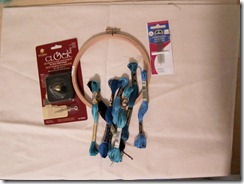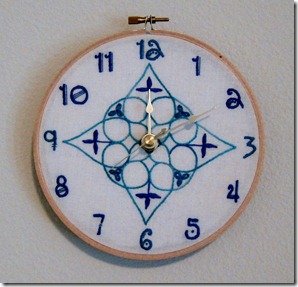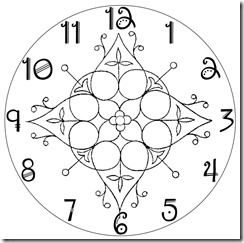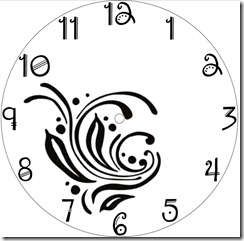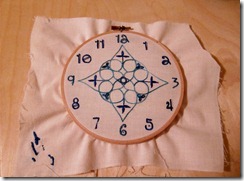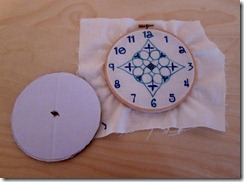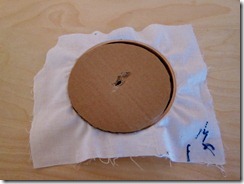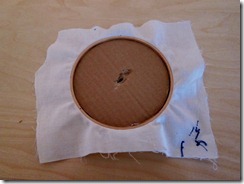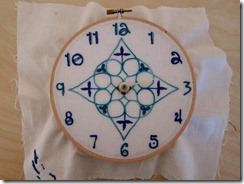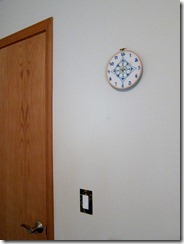So, yarn hates me right now. All I want to do is to love it (and force it to contort into thousands of tiny loops) and it stabs me in the back by getting tangled, eaten by the cat, and just in general being a pain in the butt. I would like to declare a knitting hiatus… but my hands are shaking at the mere thought of having to watch the Daily Show without something to occupy them, so maybe that’s not a good idea. I’m not sure how to solve this problem, but today I spent some time sewing instead of knitting again. I still had 2 more reusable shopping bags to make today as well as a few that I want to make for someone who will remain nameless. By the time I’m done with all of them, I’ll have made 12 shopping bags in just a few weeks! That’s a lot of sewing for me. I’m planning on making myself a new knitting bag (I got some gorgeous fabric on sale) if I can face my sewing machine after all this. While taking a break from shopping bags, I made this:


The YCD– Yarn Containment Device. The idea is to keep a ball of yarn from rolling around the floor while you try to knit from it. (I have a ball winder that makes center pull balls, so for me this is mainly to keep cats from playing with the ball.) I’ve seen all kinds of ways to do this, from putting the ball in a pot by your side to making one from an old soda bottle. (Some aren’t as fancy as that one, though.) The problem with the pot and the soda bottle is that they’re not very portable. Or pretty. You can accomplish the portable with a Ziploc baggie, but that still doesn’t solve the pretty. 🙂 Hence the pretty, squishable YCD!
The YCD I made today is about a 4″ cube (it’s a little taller than it is wide, but I’m not going to go get it to measure it.) It’s just about right to fit a skein of Louet Gems Pearl, which you can see in there. It’s got a ribbon drawstring. I wanted to use a cord stop, but I’ve run out so I just tied the ribbon in a bow. The YCD has some heavy interfacing on the bottom to help it stand up, but the sides are just two layers of cotton so that they squish nicely for storage or portability.
I’m planning on making more of these; they’re a great way to use up some fabric stash! This one was pretty fast to make, too, and I was making it up as I went along! It’s not perfect yet… I’d like to use fusible interfacing on the bottom for easier placement and probably make the top a little differently. Further experiments on the specimen are required, but if you’d like to try your hand at making one of these, read on!
The 4″ Yarn Containment Device
Supplies:
- 2 fat quarters or equivalent amount of fabric and a 3″ x 17″ piece of coordinating fabric
- 4″ square of heavy interfacing (fusible recommended)
- 18-20″ ribbon or cord
- Sewing machine, iron, freezer paper (optional,) pins, sewing needle
This project uses 1/2″ seam allowances.
On freezer paper or directly on fabric, draw the shape for the Device. The Device is based on a “plus” shape that is then folded up to make the bag. I start by making the 5″ square in the center, then measuring out the side rectangles, 5″ x 4.5″ on each side. You can see in the picture that I didn’t use a big enough piece of freezer paper and had to use masking tape to tape the sides on, lol! Cut one from the outer fabric and one from the lining.

Place a ruler on the cut piece, running from one inner corner diagonally to its opposite. Draw a line about 1/2″ long along the ruler, starting from each corner. (Since that made almost no sense, I hope the pictures help.) Carefully cut along the lines just drawn. These cuts enable the bag to fold correctly for sewing. If you’ve got fusible interfacing, you should fuse it to the wrong side of the outer fabric in the center of the plus shape now. Use the cuts as a guide for centering. If you don’t have fusible interfacing, read on!


Fold the piece in half, right sides together, so that two of the sides line up and pin in place. (See why we cut those slits now?) Sew along either of the outer sides with a 1/2″ seam allowance, from the top to the end of the slit. Don’t worry if the slit doesn’t reach the stitch line or overshoots a little, you won’t be able to tell when it’s all done.


Repeat for the other 3 sides, realigning as needed, and sew the lining the same way. (Don’t leave a hole for turning!) Trim the seam allowances to 1/4″ and turn the outer fabric right side out. Leave the lining wrong side out.


Put the outer fabric into the lining, line up the top edges, and pin into place. Sew along the upper edge, leaving a 2″ gap for turning.

Turn right side out. If you’re using plain interfacing, curl the 4″ piece up a bit and shove it through the turning hole and position it correctly. Press the top edges if desired.

Take your 3″x17″ strip of fabric (or cut it now) and fold it in half width-wise (so that you now have a long 1.5″ strip.) Press. Open it up and fold one short edge down about a 1/4″ (don’t worry about the other short edge for now.) Now, fold one long edge down to the fold line. Press. Do the same on the other long side. You’ve now got a 1″ x 17″ strip.


Open up the strip you just spent so long pressing so that you can see the center line, but the two sides are still folded in. Mark a place (anywhere, really) on the strip for two button holes. Follow your sewing machine’s instructions for making button holes. This is where the drawstring will come out. The button holes will sew through 2 layers of fabric.


Put the strip on the top of the bag, overlapping the bag by about a 1/4″. Pin in place. Hide the raw end of the strip under the pressed edge of the strip. If there’s more than a 1/2″ overlap, trim the raw end. Try to line up the button holes with the center of a side. (You can see that I didn’t really do that very well…)


Topstitch around the bottom of the strip, starting just after the pressed edge of the strip. This part was a little dicey for me, but I think it worked out well enough. Slip stitch the pressed edge to the strip section beneath it. Thread the ribbon or cord through the button holes, trim off any extra, and you’re done! Throw a ball of yarn in there and get knitting!
This YCD is good for very small balls of yarn or center-pull balls that won’t move. Depending on the size of your ball, you’ll want to make the Device larger.

This work by Cailyn Meyer is licensed under a Creative Commons Attribution-Noncommercial-Share Alike 3.0 United States License.
